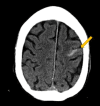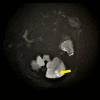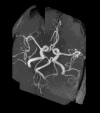Convexal Subarachnoid Hemorrhage Caused by Infective Endocarditis in a Patient with Advanced Human Immunodeficiency Virus (HIV): The Culprits and Bystanders
- PMID: 33986239
- PMCID: PMC8130978
- DOI: 10.12659/AJCR.931376
Convexal Subarachnoid Hemorrhage Caused by Infective Endocarditis in a Patient with Advanced Human Immunodeficiency Virus (HIV): The Culprits and Bystanders
Abstract
BACKGROUND Convexal subarachnoid hemorrhage (cSAH), a rare form of non-aneurysmal subarachnoid hemorrhage, is confined to cerebral convexities without extension into basal cisterns or ventricles. Typical presentation includes thunderclap/progressive headache or transient focal neurological symptoms; rare manifestations include seizures, intractable vomiting, or altered mental status. Here, we report the first case of convexal subarachnoid hemorrhage and multifocal ischemic lesions caused by infective endocarditis (IE) in a treatment-naïve advanced HIV patient. CASE REPORT A 52-year-old HAART-naïve, HIV-positive, African American man presented with altered mental status, shortness of breath, nonproductive cough, and generalized weakness. His past medical history was significant for congestive heart failure, chronic obstructive pulmonary disease, and end-stage renal disease (noncompliant with hemodialysis). Head computed tomography (CT) showed an isolated sulcal hemorrhage in the mid-left frontal lobe. Fluid-attenuated inversion recovery/gradient recalled echo sequences confirmed a hemorrhage in the left-mid-frontal sulcus, and diffusion-weighted imaging revealed multifocal bilateral ischemic lesions. Transesophageal echocardiography exhibited mitral valve vegetations. Multifocal ischemic lesions and cSAH caused by infectious endocarditis were confirmed. Initiation of intravenous vancomycin and piperacillin-tazobactam allowed the patient to have resolution of his altered mental status. A head CT 5 days later revealed the resolution of cSAH. CONCLUSIONS Infective endocarditis should be considered as an underlying etiology of cSAH, especially when present with multifocal ischemic lesions. Risk factors contributing to the development of cSAH in the IE patient population should be explored in future studies. HIV has not been previously reported in this subgroup and its prevalence should be considered. The prognosis for cSAH in relation to IE is generally favorable.
Conflict of interest statement
None.
Figures










Similar articles
-
Distinguishing clinical and radiological features of non-traumatic convexal subarachnoid hemorrhage.Eur J Neurol. 2016 May;23(5):839-46. doi: 10.1111/ene.12926. Epub 2016 Feb 22. Eur J Neurol. 2016. PMID: 26910197
-
Acute convexity subarachnoid hemorrhage (cSAH) in infectious endocarditis (IE): imaging features and follow-up.J Neurol. 2020 Oct;267(10):2971-2982. doi: 10.1007/s00415-020-09953-7. Epub 2020 Jun 3. J Neurol. 2020. PMID: 32494850
-
Serial Neuroimaging of a Patient with Minor Stroke due to Isolated Cortical Vein Thrombosis and Convexal Subarachnoid Hemorrhage.Acta Neurol Taiwan. 2016 Sep 15;25(3):104-110. Acta Neurol Taiwan. 2016. PMID: 27854089
-
Convexity Subarachnoid Hemorrhage with PiB Positive Pet Scans: Clinical Features and Prognosis.J Neuroimaging. 2015 May-Jun;25(3):420-9. doi: 10.1111/jon.12188. Epub 2014 Dec 18. J Neuroimaging. 2015. PMID: 25523388 Review.
-
Cerebral venous thrombosis as a rare cause of subarachnoid hemorrhage: case report and literature review.Clin Imaging. 2014 Jul-Aug;38(4):373-379. doi: 10.1016/j.clinimag.2014.03.005. Epub 2014 Mar 21. Clin Imaging. 2014. PMID: 24746346 Review.
Cited by
-
The First Case Report of Community-Acquired Infective Endocarditis Due to Sequence Type 1223 Staphylococcus argenteus Complicated with Convexity Subarachnoid Hemorrhage.Infect Drug Resist. 2022 Aug 29;15:4963-4970. doi: 10.2147/IDR.S373352. eCollection 2022. Infect Drug Resist. 2022. PMID: 36060234 Free PMC article.
-
Nonaneurysmal subarachnoid hemorrhage associated with COVID-19 infection: A case report.Surg Neurol Int. 2022 Nov 11;13:524. doi: 10.25259/SNI_974_2022. eCollection 2022. Surg Neurol Int. 2022. PMID: 36447843 Free PMC article.
References
-
- Beitzke M, Gattringer T, Enzinger C, et al. Clinical presentation, etiology, and long-term prognosis in patients with nontraumatic convexal subarachnoid hemorrhage. Stroke. 2011;42(11):3055–60. - PubMed
-
- Renou P, Tourdias T, Fleury O, Debruxelles S, et al. Atraumatic nonaneurysmal sulcal subarachnoid hemorrhages: A diagnostic workup based on a case series. Cerebrovasc Dis. 2012;34(2):147–52. - PubMed
-
- Dubosh NM, Bellolio MF, Rabinstein AA, Edlow JA. Sensitivity of early brain computed tomography to exclude aneurysmal subarachnoid hemorrhage: A systematic review and meta-analysis. Stroke. 2016;47(3):750–55. - PubMed
Publication types
MeSH terms
LinkOut - more resources
Full Text Sources
Other Literature Sources
Medical
Miscellaneous

